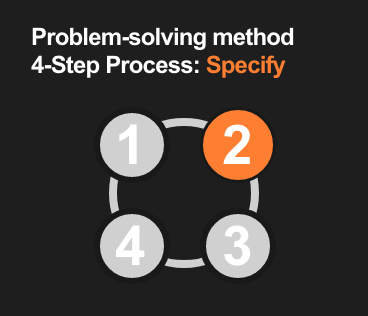Apply our problem solving method
Career Wise Menu
Follow problem solving steps: Specify the Outcome

- Learn that setting a desired outcome is a critical step in solving problems
- Learn that deciding on the outcomes you want is a form of power
In Assessing the Issue, you identified what's bothering you, reflected on your part in the problem, took into account the context and the perspectives of other people, and found the missing information. Now what?
When a problem arises, are you most likely to:
a. Keep thinking about what’s wrong?
b. Look for the quickest way to take care of it?
c. Depend on others to solve it for you?
It’s easy to get stuck in “a,” because the problem is currently affecting you, maybe almost every day in some instances. In jumping to a quick solution (b), or hoping that others will take over (c) , you are giving up your opportunity to clarify exactly what outcome you want in the situation.
Before you can ponder a solution strategy, it is critical to decide on your intended outcome. There are three aspects to specifying the outcome you want:
- 2A: Select your PRIORITY problem
- 2B: Establish what’s under your CONTROL
- 2C: Set a CONCRETE outcome
Choose which problem to work on first:
You may find that you are juggling multiple problems that all seem equally important. Although you have identified what's bothering you right now, you may have several other problems that seem equally as pressing. Trying to address several problems at once dilutes your attention and diminishes your probability of resolving the most important or pressing matter.
Before you can specify the outcome you want, you need to figure out what to work on first.
Set Priorities is a module that will assist you to become more strategic and effective at prioritizing your time.
Once you choose the most important issue to manage right now, you can start creating a specific solution.
Often, a crucial step in proceeding in any plan or situation is an assessment of those things that are under your control and conversely those things that are not. In other words, you need to look for what you can change in order to get what you want.
Keep in mind that this distinction is not always clear-cut. A good rule of thumb is that we are ONLY in control of our own thoughts, feelings, and behaviors. Remember that someone cannot make us feel or act in a certain way; rather we choose to react to them in a certain manner.
The flip side is also true, but hard to accept — that we cannot control what other people think or do. But, if we change what we do, others will probably see or respond to us differently. If this approach seems like it will take some practice to integrate, you are correct — it does, but once you begin to recognize how the view plays out, you will realize that it affords a great deal of control in many situations involving other people.
However, what’s under your control is not always interpersonal in nature. Sometimes, we must recognize that we are faced with influences like institutional policies that are controlled by any number of individuals and may fall outside of what your advisor or other stakeholders can affect. Recognizing who controls these situations may save you a great deal of time and effort.
Self-test
Lora is experiencing a number of problems lately, which is causing her to feel stressed and overwhelmed. She has been under pressure from her lab supervisor to finish a project, one of her labmates is lagging behind on his part of the project, and her supervisor is due to evaluate her at the end of the month. Further, Lora has an exam coming up. Lastly, Lora’s personal fitness is very important to her, and in all of these stressors, she feels that she hasn’t been able to make time to go to the gym, which adds to her frustration.
- A. Answers A & D
- B. Her fitness. It helps her to feel better, both physically and emotionally.
- C. Her labmate’s work. Lora should devote her time to making sure he comes through with his end of the project.
- D. Her upcoming evaluation. Lora should make a special effort to ensure she gets a good evaluation from her supervisor.
- E. Her exam. Even though her time is crunched right now, she should set aside extra time to prepare for the exam.
Focus on what’s RIGHT:
Now that you know what’s getting in your way, think of how you’d like things to be. People often get stuck on what’s “wrong” instead of envisioning what would be “right.” Create a positive statement that describes exactly what your successful outcome will look like.
- Picture the outcome you want, CONCRETELY.
This is your time to get specific with what you want the result of your efforts to look like. What exactly will be happening when you’ve been successful in solving the problem or managing your concern? What specifically will be different when you’ve reached your objective? You may find that to get to the outcome you want, you’ll have to set some intermediate milestones.
For example, if not making sufficient progress toward finishing your dissertation is the problem, then an initial concrete outcome might be something like this:
You would like your advisor to review your dissertation proposal by the beginning of next month. But what do you need to accomplish in the meantime to make that happen? You will have to polish up your writing, solicit feedback from one of your peers, and set up an initial meeting to discuss your proposal. You want to do this so you can stay on track with your goal of starting data collection by spring.
The difference between defining a problem and setting a CONCRETE OUTCOME is that one states what’s going poorly while the other envisions how things can be better.
Write your CONCRETE OUTCOME:
You would like ______________ to happen by this date__________________which will entail you doing ____________________. The reason you want to do this is because_________________.
Want more instruction on creating a concrete outcome?
The Outcome is a communication elements module that points out how identifying in advance what you want to achieve from a particular interaction can help guide you in the communication process.
Set SMART Objectives is a module that will teach you how to turn ambiguous goals or problems into tangible, attainable objectives.
Getting Married During Graduate School
The decision to get married in graduate school.
Outlines a philosophy on time management.
Compromises Outside the Realm of Children
Addresses personal relationship sacrifices.
How to seek support and not be shy in asking for help.
The importance of knowing what you want and expecting tradeoffs on the path to get it.
Asserting Yourself in the Face of Authority
The importance of standing up for yourself.
The importance of allowing yourself the opportunity to change your mind and reconsider your goals.
Pursuing Different Threads in Career Positions
Contributions to the field are reflected through choices
Apply Problem Solving Side Menu
An Arizona State University project, supported by the National Science Foundation under grants 0634519, 0910384 and 1761278
Any opinions, findings, and conclusions or recommendations expressed in this material are those of the authors and do not necessarily reflect the views of the National Science Foundation. © 2021 CareerWISE. All rights reserved. Privacy | Legal




